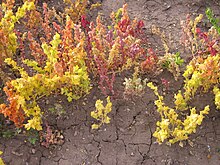
Back سرمق شاحب Arabic سرمق شاحب ARZ Chenopodium pallidicaule AST Qañiwa AY Kañiwa BR Chenopodium pallidicaule Catalan Chenopodium pallidicaule CEB Chenopodium pallidicaule Spanish Kañiwa EU Kaniwa Finnish
| Chenopodium pallidicaule | |
|---|---|

| |
| Chenopodium pallidicaule growing in Atuncolla near Sillustani, Peru, at an elevation of ca. 3,900 metres | |
| Scientific classification | |
| Kingdom: | Plantae |
| Clade: | Tracheophytes |
| Clade: | Angiosperms |
| Clade: | Eudicots |
| Order: | Caryophyllales |
| Family: | Amaranthaceae |
| Genus: | Chenopodium |
| Species: | C. pallidicaule
|
| Binomial name | |
| Chenopodium pallidicaule Aellen
| |
Chenopodium pallidicaule, known as cañihua, canihua or cañahua (from Quechua 'qañiwa, qañawa or qañawi')[1][2][3] and also kañiwa or kaniwa, is a species of goosefoot, similar in character and uses to the closely related quinoa (Chenopodium quinoa).
Cañihua is native to the Andean region, with more than 200 varieties, and it has been farmed in the Altiplano for millennia. As a crop, cañihua has distinct characteristics, including tolerance of high mountain conditions, high content of protein and dietary fiber, and rich phenolic content.[4][5][6]
- ^ Teofilo Laime Ajacopa, Diccionario Bilingüe Iskay simipi yuyayk'ancha, La Paz, 2007 (Quechua-Spanish dictionary)
- ^ Diccionario Quechua - Español - Quechua, Academía Mayor de la Lengua Quechua, Gobierno Regional Cusco, Cusco 2005 (Quechua-Spanish dictionary)
- ^ "babylon.com/". Archived from the original on 2016-03-04. Retrieved 2014-05-04.
- ^ Peñarrieta, JM; Alvarado, JA; Akesson, B; Bergenståhl, B (June 2008). "Total antioxidant capacity and content of flavonoids and other phenolic compounds in canihua (Chenopodium pallidicaule): an Andean pseudocereal". Mol Nutr Food Res. 52 (6): 708–17. doi:10.1002/mnfr.200700189. PMID 18537130.
- ^ Repo-Carrasco-Valencia, Ritva; Acevedo de la Cruz, Alexander; Icochea Alvarez, Julio Cesar; Kallio, Heikki (2009). "Chemical and Functional Characterization of Kañiwa (Chenopodium pallidicaule) Grain, Extrudate and Bran". Plant Foods for Human Nutrition. 64 (2): 94–101. doi:10.1007/s11130-009-0109-0. PMID 19424801. S2CID 38974981.
- ^ Vega-Gálvez, Antonio; Miranda, Margarita; Vergara, Judith; Uribe, Elsa; Puente, Luis; Martínez, Enrique A (2010). "Nutrition facts and functional potential of quinoa (Chenopodium quinoa willd.), an ancient Andean grain: A review". Journal of the Science of Food and Agriculture. 90 (15): 2541–7. Bibcode:2010JSFA...90.2541V. doi:10.1002/jsfa.4158. hdl:10533/142976. PMID 20814881.